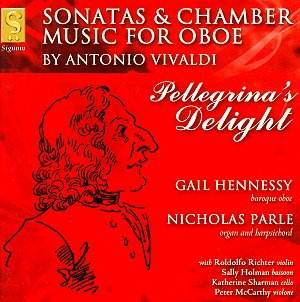This
release ’Pellegrina’s Delight’ is a joy from start to finish and
a testament to Vivaldi’s undoubted genius. It is good to have
this wonderful disc of Vivaldi works imaginatively themed around
the oboe and a most welcome change too from yet another version
of the ubiquitous ‘Four Seasons‘!
It
is easy to forget just how popular the oboe was in Vivaldi’s time
when it was the principal woodwind instrument and was often used
for solo display. We are informed in the excellent booklet notes
that Vivaldi inscribed his autographed manuscript of the Sonata
in C major, RV 779 with the names of his four chosen female
performers from the Ospedale della Pieta, in Venice. The soloist
who played the oboe was named Pellegrina, hence the artistic subtitle
’Pellegrina’s Delight’ given to this Signum release.
The
Sonata in C minor for oboe and basso continuo RV 53 was
the only work that Vivaldi composed purely as a solo work for
the oboe. The six other works on this release use the oboe as
part of a small combination of solo instruments or are works usually
played by solo violin(s), where it is thought that Vivaldi may
have equally intended them to performed by the oboe or another
appropriate solo instrument.
What
is particularly impressive in this selection of chamber works
is how Vivaldi finds a wide variety of expression and a kaleidoscope
of colours. There is a free-flowing stream of joy and invention
with the additional benefit of memorable tunes. All the chosen
works on the release are really exceptional, however I must single
out the remarkable and appealing Sonata in C major for oboe,
organ, violin and bassoon, RV 779 for special praise. The
interplay of the quartet of instruments is impressive and Vivaldi
excels himself with the imaginative blend of variety, tone colour
and lyricism. I just love Vivaldi’s inspired use of the baroque
organ in the score that so reminded me of a fair-ground organ.
All
the performers play period instruments and are specialists in
early-music performance being members of more authentic instrument
ensembles than you could shake a stick at. Only the American Gail
Hennessy on the baroque oboe and Australian Nicholas Parle, the
organist and harpsichordist feature on all seven works. Hennessey
is an oboist of the utmost quality, as can be heard in the largo
section of the Sonata in G minor, RV 28, on track 11,
point 01:36, where she shrugs aside the technical demands of her
period instrument and exhibits virtuoso playing of the highest
order. The baroque organ and harpsichord playing is also out of
the top-drawer. Just listen to Parle’s performance of skill and
technical mastery in the andante of the Sonata in C
major, RV 779 on track 5, point 03:02. In fact, the
credentials of all the players are most impressive. Only the other
evening at a BBC Promenade Concert, violinist Rodolfo Richter
could be seen leading the combined orchestral forces of the Academy
of Ancient Music, The English Concert and the Royal Academy of
Music.
The
performance of the ensemble players is a delight, so intensely
alive with a feeling of the real joy of music making. At times
it sounds and feels like there is a full baroque orchestra playing,
not just four players as heard in the andante of the Sonata
in G major, RV 779 on track 5, point 00:20. What immediately
strikes me is how clear and rich the finely tuned period instruments
sound, particularly the plangent tone of Gail Hennessy’s baroque
oboe, which can be heard to great effect in the adagio
of the Sonata in C minor, RV 53, on track 1, point 00:25.
Vivaldi’s writing is superb and although the adage states that
music cannot be played better than what it is, the players almost
succeed.
This
a release to savour and the leading candidate for both my baroque
and chamber record of the year. A special recording which I recommended
with my strongest advocacy.
Michael
Cookson

